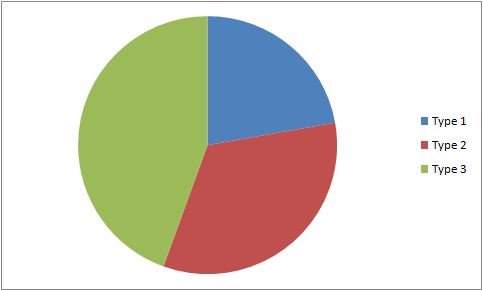In this discussion, we are going to look at a very important concept in mathematics. It is a very simple concept and is easy to understand. We are going to discuss the concept of equal parts and unequal parts.
Suggested Videos
Equal and Unequal Parts
To understand this concept let us have a brief overview of the topic of fractions.
Fractions
We denote division using fractions. A fraction is represented as ‘\( \frac {p}{q} \)‘. For example, we can say \( \frac{1}{2} \), \( \frac{3}{5} \), \( \frac{6}{9} \), etc are all fractions.
Division
We know that we denote division using fractions. Let us take a fraction as \( \frac {3}{5} \). What this fraction means that we are dividing 3 into 5 parts or taking 3 parts out of 5. Let us understand this mathematically. Consider a number say 10. Now let us apply the above fraction to it.
So, \( \frac{3}{5} \) parts of 10
= \( \frac{3}{5} \) × 10
Or, = \( \frac{3×10}{5} \)
= \( \frac{30}{5} \)
= 6
Thus, we see that \( \frac{3}{5} \) parts of 10 are 6. With this concept clear, let us proceed to the main topic of our discussion
Equal Parts
We have cut a circle into 4 parts. Each part is of the same size as the other 3 parts. Since the circle is divided into 4 equal parts, each part is called as one-fourth or \( \frac{1}{4} ^{^{th}} \) of the circle. We call ‘one-fourth’ of anything as ‘Quarter’
Similarly, the circle in this image is divided into three equal parts. Equal parts of a whole are similar in shape and size.
Equal Fractions
In terms of fractions, two fractions are said to be equal if they can be reduced to equal lowest forms. For example, consider the fractions \( \frac{20}{40} \) and \( \frac{30}{60} \). Now let us reduce both these fractions to their lowest forms.
\( \frac{20}{40} = \frac{2×10}{4×10} \)
= \( \frac{2}{4} = \frac{2×1}{2×2} \)
= \( \frac{1}{2} \)
Similarly, \( \frac{30}{60} = \frac{3×10}{6×10} \)
= \( \frac{3}{6} = \frac {3×1}{3×2} \)
= \( \frac{1}{2} \)
Thus we see that both \( \frac{20}{40} \) and \( \frac{30}{60} \) have their lowest form as \( \frac{1}{2} \). This means that both these fractions are equal i.e. they are equal in parts. Thus, \( \frac{20}{40} = \frac{30}{60} = \frac{1}{2} \)
Unequal Parts
Two parts of a whole are said to be unequal when they do not match each other in terms of size and value.

In the above image, we see that the circle is divided into 3 parts. However, none of the parts is equal to each other in shape and size. Thus, we call them Unequal parts. In terms of fractions, two fractions are said to be unequal to each other if their lowest forms are not equal to each other.
Consider for example 2 fractions \( \frac{20}{40} \) and \( \frac{30}{40} \). Let us reduce both these fractions to their lowest forms. Thus,
\( \frac{20}{40} = \frac{2×10}{4×10} \)
= \( \frac{2}{4} = \frac{2×1}{2×2} \)
= \( \frac{1}{2} \)
And \( \frac{30}{40} = \frac{3×10}{4×10} \)
= \( \frac {3}{4} = \frac{3×1}{4×1} \)
= \( \frac{3}{4} \)
The lowest forms of the fractions \( \frac{20}{40} = \frac{1}{2} \) and \( \frac{30}{40} = \frac{3}{4} \). But we know \( \frac{1}{2} \) is not equal to \( \frac{3}{4} \). Thus, \( \frac{20}{40} \) is not equal to \( \frac{30}{40} \). Both these fractions have different lowest forms. Thus, they are Unequal parts.
Solved Examples for You
Question: From the given fractions determine which of the fractions are equal in parts.
\( \frac{3}{9} , \frac{4}{16} , \frac{6}{24} \)
Solution: To find equal parts we reduce each fraction to its lowest form and compare them with each other. Thus,
\( \frac{3}{9} = \frac{3×1}{3×3} = \frac{1}{3} \)
\( \frac{4}{16} = \frac {4×1}{4×4} = \frac {1}{4} \)
\( \frac{6}{24} = \frac {6×1}{6×4} = \frac {1}{4} \)
As we can see the lowest forms of \( \frac{4}{16} \) and \( \frac{6}{24} \) are equal to each other. So, \( \frac{4}{16} = \frac{6}{24} \) are equal parts. The lowest form of \( \frac{3}{9} \) is not equal to the lowest forms of \( \frac{4}{16} \) and \( \frac{6}{24} \). Thus, \( \frac{3}{9} \) , \( \frac{4}{16} \) and \( \frac{6}{24} \) are unequal parts.






Can you make something divisible by unequal parts? How would you write it out? For example the circle pictured above with unequal parts. how would you arrive mathematically to know what that circle looks like?